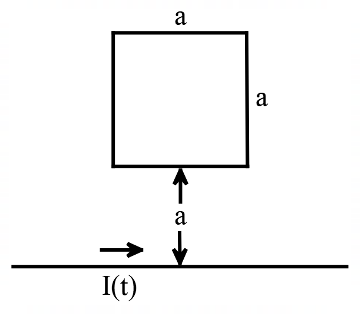71. Three point charges q, q and -2q are located at (0, -a, a), (0, a, a) and (0, 0, -a), respectively. The net dipole moment of this charge distribution is
72. Consider the following three independent cases:
i. Particle A of charge +q moves in free space with a constant velocity $$\overrightarrow {\bf{v}} $$ (v ≪ speed of light).
ii. Particle B of charge +q moves in free space in a circle of radius R with same speed v as In case i.
iii. Particle C having charge -q moves as in case ii.
If the powers radiated by A, B and C are PA, PB and PC respectively then
i. Particle A of charge +q moves in free space with a constant velocity $$\overrightarrow {\bf{v}} $$ (v ≪ speed of light).
ii. Particle B of charge +q moves in free space in a circle of radius R with same speed v as In case i.
iii. Particle C having charge -q moves as in case ii.
If the powers radiated by A, B and C are PA, PB and PC respectively then
73. An infinitely long wire carrying a current $$I\left( t \right) = {I_0}\cos \left( {\omega t} \right)$$ is placed at a distance a from a square loop of side a as shown in the figure. If the resistance of the loop is R, then the amplitude of the induced current in the loop is


74. A large circular coil of N turns and radius R carries a time varying current $$I = {I_0}\sin \left( {\omega t} \right).$$ A small circular coil of n turns and radius r(r ≪ R) is placed at the centre of the large coil such that the coils are concentric and coplanar. The induced emf in the small coil
75. A conducting loop L of surface area S is moving with a velocity $$\overrightarrow {\bf{v}} $$ in a magnetic field $$\overrightarrow {\bf{B}} \left( {\overrightarrow {\bf{r}} ,\,t} \right) = {B_0}{t^2},\,{B_0}$$ is a positive constant of suitable dimensions. The emf
induced Vemf in the loop is given by
76. Unpolarized light falls from air to a planar air-glass interface (refractive index of glass is 1.5) and the reflected light is observed to be plane polarized. The polarization vector and the angle of incidence θi are
77. Consider the given statements about E(r, t) and B(r, t), the electric and magnetic vectors respectively in a region of free space
P. Both E and B are conservative vector fields.
Q. Both E and B are central force fields.
R. E and B are mutually perpendicular in the region.
S. Work done by B on a moving charge in the region is zero.
Choose the right combination of correct statements from the following.
P. Both E and B are conservative vector fields.
Q. Both E and B are central force fields.
R. E and B are mutually perpendicular in the region.
S. Work done by B on a moving charge in the region is zero.
Choose the right combination of correct statements from the following.
78. Given a wave with the dispersion relation, ω = ck + m for k > 0 and m > 0, which one of the
following is true?
79. An insulating sphere of radius a carries a charge density $$\rho \left( {\overrightarrow {\bf{r}} } \right) = {\rho _0}\left( {{a^2} - {r^2}} \right)\cos \theta ;\,r < a.$$ The leading order term for the electric field at a distance d, far away from the charge distribution, is proportional to
80. At the interface between two linear dielectrics (with dielectric constants $${{\varepsilon _1}}$$ and $${{\varepsilon _2}}$$), the electric field lines bend, as shown in the figure. Assume that there are no free charges at the interface. The ratio $$\frac{{{\varepsilon _1}}}{{{\varepsilon _2}}}$$ is


